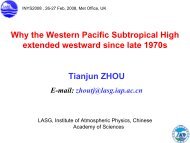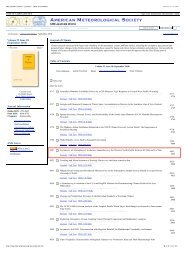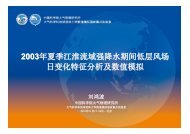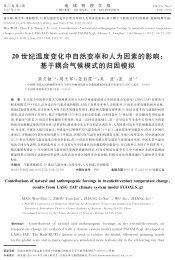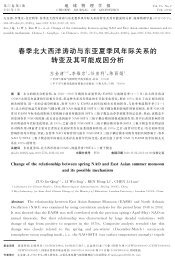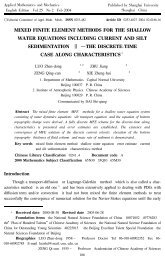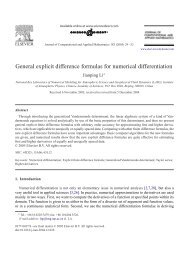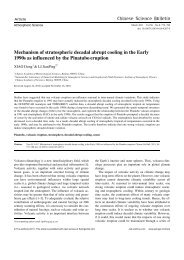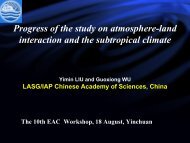ä¼ç§ç¾¤ä½ï¼æ¨¡å¼å¢éæ»ç»
ä¼ç§ç¾¤ä½ï¼æ¨¡å¼å¢éæ»ç»
ä¼ç§ç¾¤ä½ï¼æ¨¡å¼å¢éæ»ç»
You also want an ePaper? Increase the reach of your titles
YUMPU automatically turns print PDFs into web optimized ePapers that Google loves.
优 秀 群 体 - 模 式 团 队 总 结<br />
吴 国 雄<br />
2006 年 12 月 18 日 , 北 京 香 山
…… 发 表 论 文 3-5 篇 , 包 括 SCI 论 文 1-2 篇 。<br />
模 式 团 队 05-06 年 总 结<br />
主 要 研 究 内 容<br />
1. 检 验 FGOALS-SR42L9 和 R42L26 模 拟 东<br />
亚 季 风 气 候 和 热 带 海 气 相 互 作 用 的 能 力 。<br />
2. 利 用 ERA40 和 NCEP/NCAR 再 分 析 资 料 认<br />
识 中 国 区 域 气 候 特 征 及 变 化 规 律 。<br />
3. 开 展 青 藏 高 原 和 南 亚 次 大 陆 分 布 的 敏 感 试 验<br />
, 为 改 进 中 国 区 域 气 候 模 拟 提 供 改 进 思 路 。<br />
目 标
一 、 两 年 来 的 研 究 进 展 和 成 果<br />
1. 欧 亚 地 形 对 不 同 季 节 大 气 环 流 的 影 响 的 数 值 模 拟 研 究<br />
2. 青 藏 高 原 加 热 如 何 影 响 亚 洲 夏 季 的 气 候 格 局<br />
3. 青 藏 高 原 对 于 亚 洲 夏 季 风 的 爆 发 地 点 的 锚 定 作 用<br />
4. 热 带 非 洲 和 南 亚 次 大 陆 在 亚 洲 季 风 形 成 中 的 作 用<br />
5. GOALS 模 式 中 大 气 能 量 循 环 的 诊 断 分 析<br />
6. LASG/IAP 大 气 环 流 谱 模 式 对 陆 面 过 程 的 敏 感 性 试 验<br />
7. 大 气 环 流 谱 模 式 (SAMIL) 耦 合 前 后 性 能 的 比 较
二 、 发 表 论 文 情 况 : 论 文 12 篇 , 内 SCI4 篇<br />
青 藏 高 原 加 热 如 何 影 响 亚 洲 夏 季 的 气 候 格 局<br />
The role of land-sea distribution in the formation of the<br />
Asian summer monsoon<br />
吴 国 雄 、 刘 屹 岷 、 刘 新 、 段 安 民<br />
、 梁 潇 云<br />
Xiaoyun Liang, Yimin Liu, and<br />
Guoxiong Wu<br />
大 气 科 学 2005,29(1):47-56<br />
CSCD<br />
Geoph. Res. Lett. 2005, 32: 10.1029/2004GL021587<br />
SCI<br />
Heating Status of the Tibetan Plateau from April to June<br />
and rainfall and atmospheric circulation anomaly over<br />
East Asia in midsummer<br />
Role of the Tibetan Plateau thermal forcing in the<br />
summer climate patterns over subtropical Asia<br />
Duan Anmin, Liu Yimin and Wu<br />
Guoxiong<br />
Science in China (D) 2005, 48 (2): 250-257<br />
SCI<br />
Duan Anmin and Wu Guoxiong★ Climate Dynamics 2005, 24: 793-807<br />
SCI<br />
欧 亚 地 形 对 不 同 季 节 大 气 环 流 影 响 的 数 值 模 拟 研 究 吴 国 雄 , 王 军 , 刘 新 , 刘 屹 岷 气 象 学 报 2005,63(5): 603-612<br />
CSCD<br />
青 藏 高 原 对 亚 洲 夏 季 风 爆 发 位 置 及 强 度 的 影 响 梁 潇 云 , 刘 屹 岷 , 吴 国 雄 气 象 学 报 2005,63(5): 799-805<br />
CSCD<br />
基 于 LASG/IAP 大 气 环 流 谱 模 式 的 气 候 系 统 模 式<br />
GOALS 模 式 中 大 气 能 量 循 环 的 诊 断 分 析 与 不 同 版 本 计 算<br />
结 果 的 比 较 研 究 。<br />
周 天 军 , 王 在 志 , 宇 如 聪 , 俞 永<br />
强 , 刘 屹 岷 , 刘 海 龙 , 包 庆 , 王<br />
鹏 飞 , 李 薇 , 吴 国 雄<br />
气 象 学 报 2005,63(5): 702-715<br />
CSCD<br />
张 韬 , 吴 国 雄 , 郭 裕 福 , 大 气 科 学 2006:30(1),38-55<br />
CSCD<br />
LASG/IAP 大 气 环 流 谱 模 式 对 陆 面 过 程 的 敏 感 性 试 验 。<br />
A comparison between two versons of the GOALS model<br />
in an atmospheric energy cycle diagnosis.<br />
The Influence of the Mechanical and Thermal Forcing of<br />
the<br />
Tibetan Plateau on the Asian Climate<br />
大 气 环 流 谱 模 式 (SAMIL) 耦 合 前 后 性 能 的 比 较<br />
包 庆 , 刘 屹 岷 , 周 天 军 , 王 在 志<br />
, 吴 国 雄 , 王 鹏 飞<br />
Zhang Tao, Wu Guoxiong, Guo<br />
Yufu, and Su Lin<br />
Guoxiong Wu, Yimin Liu,<br />
Tongmei Wang, Rijin Wan, …<br />
王 在 志 , 宇 如 聪 , 包 庆 , 周 天<br />
军 , 吴 国 雄 , 刘 屹 岷 , 王 鹏 飞<br />
大 气 科 学 2006:30(6),1077-1090<br />
CSCD<br />
Chinese J. Atmos.<br />
Sci.,<br />
2006: 30(2), 195-216.<br />
J. Hydrometeorology Accepted<br />
SCI<br />
大 气 科 学 待 发 表<br />
CSCD
大 气 环 流 谱 模 式 (SAMIL) 耦 合 前 后 性 能 的 比 较<br />
• 形 成 了 可 插 拔 的 海 - 陆 - 气 - 冰 “ 非 通 量 调 整 ” 的 直 接 耦 合 的<br />
气 候 模 式 系 统 (FGOALS-s)<br />
• 表 明 : 耦 合 前 、 后 大 气 环 流 的 基 本 特 征 相 似 , 都 能 成 功 地 模<br />
拟 出 主 要 的 环 流 系 统 分 布 及 季 节 变 化<br />
• 海 温 和 海 冰 的 模 拟 存 在 系 统 性 的 偏 差 - 除 与 海 洋 模 式 中 经 向<br />
热 输 送 偏 弱 、 海 冰 模 式 中 海 冰 处 理 等 有 关 外 , 也 与 大 气 模 式<br />
中 总 云 量 模 拟 偏 低 有 关<br />
• 大 气 模 式 本 身 的 误 差 , 特 别 是 云 、 辐 射 过 程 带 来 的 误 差 , 对<br />
耦 合 结 果 具 有 极 为 重 要 的 影 响<br />
• 在 亚 洲 季 风 区 , 耦 合 后 季 风 环 流 及 降 水 等 的 分 布 都 比 耦 合 前<br />
单 独 大 气 模 式 的 结 果 合 理
a<br />
b
优 秀 群 体 06 年 总 结<br />
主 要 研 究 内 容<br />
研 究 青 藏 高 原 及 亚 洲 南 部 海 陆 分 布 对 亚 洲 季 风 爆 发 进 程 的<br />
影 响 , 为 改 进 季 风 爆 发 的 气 候 预 测 提 供 理 论 依 据 ;<br />
2006 年<br />
拟 利 用 Ertel 位 涡 方 程 、Hynes and MacIntyre 的 位 涡 理 论 ,<br />
结 合 热 力 适 应 理 论 和 Gill 型 的 非 对 称 Rossby 流 型 的 分 析 , 通 过<br />
历 史 资 料 诊 断 分 析 、 理 论 研 究 和 数 值 试 验 去 研 究 青 藏 高 原 上 空<br />
加 热 的 季 节 变 化 所 激 发 的 位 涡 制 造 及 其 对 气 候 的 影 响
二 、 优 秀 群 体 发 表 论 文 情 况<br />
黄 河 流 域 中 上 游 水 分 收 支<br />
以 及 再 分 析 资 料 可 用 性 分<br />
析<br />
热 带 海 陆 分 布 和 青 藏 高 原<br />
在 亚 洲 夏 季 风 形 成 中 的 作<br />
用<br />
赵 瑞 霞 , 吴 国 雄 自 然 科 学 进 展 2006:6(3):316-324 CSCD<br />
梁 潇 云 , 刘 屹 岷 , 吴 国 雄 , 地 球 物 理 学 报 2006: SCIE<br />
A comparison between two<br />
versons of the GOALS<br />
model in an atmospheric<br />
energy cycle diagnosis.<br />
The Influence of the<br />
Mechanical and Thermal<br />
Forcing of the<br />
Tibetan Plateau on the<br />
Asian Climate<br />
大 气 环 流 谱 模 式 (SAMIL<br />
) 耦 合 前 后 性 能 的 比 较<br />
Zhang Tao, Wu Guoxiong,<br />
Guo Yufu, and Su Lin<br />
Guoxiong Wu, Yimin Liu,<br />
Tongmei Wang, Rijin Wan,<br />
Xin Liu, Weiping Li, Zaizhi<br />
Wang, Qiong Zhang,<br />
Anmin Duan and Xiaoyun<br />
Liang<br />
王 在 志 , 宇 如 聪 , 包 庆 ,<br />
周 天 军 , 吴 国 雄 , 刘 屹 岷<br />
, 王 鹏 飞<br />
Chinese J.<br />
Atmos. Sci.,<br />
J.<br />
Hydrometeorolo<br />
gy<br />
2006: 30(2), 195-216.<br />
Accepted<br />
SCI<br />
大 气 科 学 待 发 表 CSCD
三 、2007 年 计 划<br />
团<br />
队<br />
1. 进 一 步 检 验 SAMIL 和 F-GOALS 的 误 差<br />
2. 改 进 热 带 水 汽 和 降 水 的 模 拟<br />
3. 完 善 云 - 辐 射 方 案 , 引 进 气 溶 胶 直 接 和 半 - 直 接 效 应<br />
4. 深 入 进 行 亚 洲 季 风 模 拟<br />
群<br />
体<br />
1. 青 藏 高 原 - 印 度 洋 - 澳 大 利 亚 热 力 差 异 的 季 节 变 化 对 亚<br />
洲 季 风 的 影 响<br />
2. 南 亚 海 陆 热 力 对 比 的 季 节 变 化 所 激 发 的 位 涡 制 造 及 其 对<br />
季 风 爆 发 的 影 响 , 揭 示 其 相 关 机 制 , 为 改 进 季 风 爆 发 的<br />
气 候 预 测 提 供 理 论 依 据 ;
Impacts of Tibetan Plateau on<br />
Asian monsoon<br />
--The TP Sensible Heat Driving Air-Pump<br />
(TP-SHAP) and Asian Climate<br />
WU Guoxiong, LIU Yimin, LIU Xin, Li Weiping, Duan Anmin,<br />
Liang Xiaoyun, Wan Rijin, Wang Tongmei<br />
State Key Lab of Atmospheric Sciences and Geophysical Fluid<br />
Dynamics (LASG)<br />
Institute of Atmospheric Physics (IAP)<br />
Chinese Academy of Sciences (CAS)<br />
December 18, 2006, Xianshang/Beijing
LIST<br />
I. Continental heating, TP heating and the<br />
summertime circulation<br />
II. Thermal adatation, Sensible heat driven<br />
air-pump (SHAP) over TP<br />
III. Persistent Rainfall in Early Spring(PRES)<br />
IV. Seasonal transition of circulation and<br />
Asian monsoon onset<br />
V. Concluding remarks
Summertime Subtropical Continental Heating<br />
Summertime subtropical quadruplet heating<br />
And the associated circulation patterns<br />
1. Wu, Guoxiong and Yimin Liu, 2003: Summertime quadruplet heating pattern in the<br />
subtropics and the associated atmospheric circulation. Geophys. Res. Lett., 30(5),<br />
1201, 5_1-4.<br />
2. Yimin Liu, Guoxiong Wu, And Rongcai Ren, 2004: Relationship between the<br />
Subtropical Anticyclone and Diabatic Heating. J. Climate, 2004, 17: 682-698.<br />
3. Wu, Guoxiong, Yimin Liu, Jianyu Mao, Xin Liu and Weiping Li. 2004: Adaptation<br />
of the atmospheric circulation to thermal forcing over the Tibetan Plateau.<br />
Observation, Theory and Modeling of the Atmospheric Variability. Selected Papers<br />
of Nanjing Institute of Meteorology Alumni in Commemoration of Professor JiJia<br />
Zhang, Edited by Xun Zhu etc.World Scientific 92-114.
Thermal Adaptation<br />
Z<br />
A<br />
N<br />
C<br />
E<br />
w ∝ − β ∂<br />
∂<br />
v<br />
z
Mosaics of the summertime<br />
subtropical heating LOSECOD<br />
and the associated circulations
a<br />
PNAA<br />
AAEA<br />
b<br />
PNAA<br />
AAEA<br />
c<br />
LOSECOD<br />
d
a<br />
PSAm ASAf IAU<br />
b<br />
PSAm<br />
ASAf<br />
IAU<br />
c<br />
LOSECOD<br />
d
Summertime Tibetan Plateau LOCAL Heating
a b c<br />
Nov<br />
Nov<br />
Nov<br />
Sep<br />
Sep<br />
Sep<br />
Jul<br />
Jul<br />
Jul<br />
May<br />
May<br />
May<br />
Mar<br />
Mar<br />
Mar<br />
Jan<br />
Jan<br />
Jan<br />
Seasonal evolutions of (a) column integrated total heating (dashed curve with open circles) and surface sensible heating<br />
(solid curve with solid circles) averaged over TP (80-100°E, 27.5-37.5°N); (b) surface sensible heating averaged over 27.5-<br />
37.5°N; and (c) column integrated total heating averaged over 80-100°E calculated from the monthly climatology of<br />
NCEP/NCAR reanalysis for 1980-1997. Unit is W m-2. Contour interval is 30 W m -2 in (b) and 50 W m -2 in (c). Values of<br />
more than 30 W m -2 in (b) and 50 W m -2 in (c) are lightly shaded and in thin-solid contour, while those of negative in (b)<br />
and (c) are bounded by heavy solid curves and indicated by heavy shading and dotted contours.
Tibetan<br />
July<br />
气 压 (hPa)<br />
气 压 (hPa)<br />
Rockies<br />
July<br />
Andes<br />
January
a) Without<br />
mountain<br />
b) With<br />
mountain<br />
b) –a)
a<br />
b<br />
c
Conclusion 1:<br />
TP is located to the central and eastern Eurasian<br />
Continent. The circulations forced by TP local<br />
thermal forcing and by continental scale heating in<br />
summer are in phase. Wet monsoon to the east and<br />
dry climate to the west of the Continent are<br />
therefore intensified by TP.
LIST<br />
I. Continental heating, TP heating and the<br />
summertime circulation<br />
II. Thermal adatation, Sensible heat driving<br />
air-pump (SHAP) over TP<br />
III. Persistent Rainfall in Early Spring(PRES)<br />
IV. Seasonal transition of circulation and<br />
Asian monsoon onset<br />
V. Concluding remarks
Jul.<br />
Jan.
a Jan<br />
b Jul<br />
Distributions of the monthly mean stream field composed of horizontal wind deviations at 10m from<br />
the corresponding annual means of 1979-1998 NCEP/NCAR reanalysis. (a) January; (b) July. Dark<br />
shadings highlight elevations higher than 3000 m. Rectangle indicates the Tibetan Plateau area as<br />
defined in the text.
(a)<br />
4 8
V and w at σ=0.991
θ 2<br />
θ 1<br />
Pumping<br />
θ 2<br />
θ 1<br />
Pumping<br />
θ 2<br />
θ 1<br />
No Pumping<br />
U, w and θ vertical cross- section
Conclusion 3:<br />
TP Air- Pump is driven by surface sensible heating<br />
(SHAP), which regulates the surrounding<br />
circulation and affects the world circulation
LIST<br />
I. Continental heating, TP heating and the<br />
summertime circulation<br />
II. Thermal adatation, Sensible heat driven<br />
air-pump (SHAP) over TP<br />
III. Persistent Rainfall in Early Spring(PRES)<br />
IV. Seasonal transition of circulation and<br />
Asian monsoon onset<br />
V. Concluding remarks
063-06 JHM 776<br />
a<br />
b<br />
Winter pattern:<br />
Asymmetric Dipole<br />
Summer pattern:<br />
Cyclonic Convergent<br />
Spiral<br />
Distributions at 850 hPa of the potential temperature (unit is K) and of the<br />
stream fields composed of wind deviations from the corresponding zonal<br />
means based on the NCEP/NCAR Reanalysis for 1968-1997. (a) Winter<br />
average between December and February; (b) Summer average between<br />
June and August.
Distribution of mean rainfall in the period of PRES (Pentad 12-26) over China<br />
averaged between 1951 and 2000. Unit is mm d-1. Shading indicates where<br />
the elevation exceeds 600 meters.<br />
063-06 JHM 776
063-06 JHM 776<br />
a<br />
b<br />
Distributions of (a) wind vector at 850hPa and (b) rainfall (unit: mm d-1) in<br />
spring (March and April means) averaged over 10 years as simulated in the<br />
model GOALS-SAMIL. The shaded areas are where elevation exceeds 2,500<br />
m.
a<br />
b<br />
c<br />
d<br />
e<br />
f<br />
Distributions of wind vector and isotach at 850 hPa (left panels, unit is m s-1,<br />
shaded gindicate exceeding 4 m s-1) and rain (right h panels, unit is mm d-1) in<br />
the perpetual spring sensitivity experiments with different TP elevations and<br />
averaged over 30 months. The black shaded in left panels and bold solid curve<br />
in right panels are the main part of TP. The TP maximum elevation is 0 km in (a)<br />
and (b), 2 km in (c) and (d), 4 km in (e) and (f), and 6 km in (g) and (h).
LIST<br />
I. Continental heating, TP heating and the<br />
summertime circulation<br />
II. Thermal adatation, Sensible heat driving<br />
air-pump (SHAP) over TP<br />
III. Persistent Rainfall in Early Spring(PRES)<br />
IV. Seasonal transition of circulation and<br />
Asian monsoon onset<br />
V. Concluding remarks
IV. Seasonal Transition of<br />
circulation and Asian<br />
monsoon onset
du / dz = −λdT<br />
/<br />
dy<br />
Z<br />
Z<br />
E<br />
W<br />
E<br />
W<br />
S<br />
warm<br />
cold<br />
N<br />
S<br />
cold<br />
warm<br />
N<br />
Winter Type<br />
Summer Type
∂ T / ∂y<br />
BOB<br />
SCS<br />
IND<br />
− ∂u/<br />
∂z<br />
BOB<br />
SCS<br />
IND<br />
OLR<br />
SCS<br />
IND<br />
BOB
May<br />
Jun<br />
在 理 想 试 验 中 , 当 亚 洲 季 风 爆 发 时 (5 月 ) 降 水 ( 上 ) 和 850hPa 风 场 ( 下 ) 的 分 布<br />
理 想 试 验 设 计 :<br />
试 验 WTP ( 左 ): 在 理 想 海 陆 分 布 上 添 加 一 个 中 心 位 于 87.5 o E,32.5 o N, 中 心 高 度 为 6000m 的 理 想 高 原 。<br />
试 验 WTP ( 左 ): 在 理 想 海 陆 分 布 上 添 加 一 个 中 心 位 于 60.0 o E,32.5 o N, 中 心 高 度 为 6000m 的 理 想 高 原 。
Conclusion 4:<br />
One of the functions of the TP SHAP is to anchor<br />
the Asian summer monsoon onset over the region<br />
from eastern Bay of Bengal (BOB) to western<br />
Indochina Peninsula.
LIST<br />
I. Continental heating, TP heating and the<br />
summertime circulation<br />
II. Thermal adatation, Sensible heat driving<br />
air-pump (SHAP) over TP<br />
III. Persistent Rainfall in Early Spring(PRES)<br />
IV. Seasonal transition of circulation and<br />
Asian monsoon onset<br />
V. Concluding remarks
4. One of the functions of the TP SHAP is to anchor the Asian<br />
summer monsoon onset over the region from eastern Bay of<br />
Bengal (BOB) to western Indochina Peninsula.<br />
V. Concluding remarks<br />
1. The circulations forced by TP local thermal forcing and by<br />
continental scale heating in summer are in phase. Wet<br />
monsoon to the east and dry climate to the west of the<br />
Continent are therefore intensified by TP.<br />
2. TP Air- Pump is driven by surface sensible heating (SHAP),<br />
which regulates the surrounding climate and affects the world<br />
circulation<br />
3. TP forces an asymmetric dipole in winter and a cyclonic<br />
convergent spiral deviation streamline pattern (PRES)
THE END<br />
THANK YOU!



